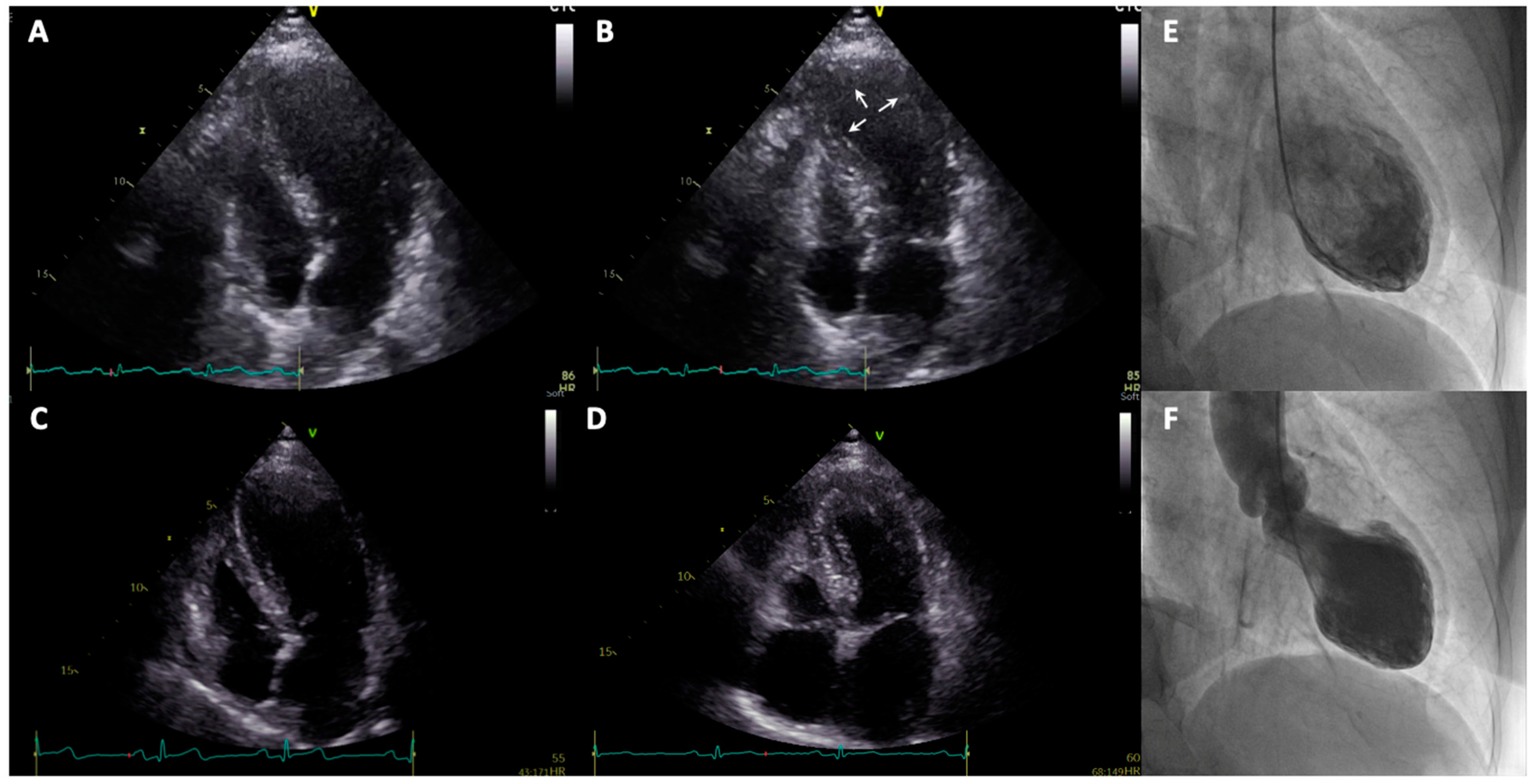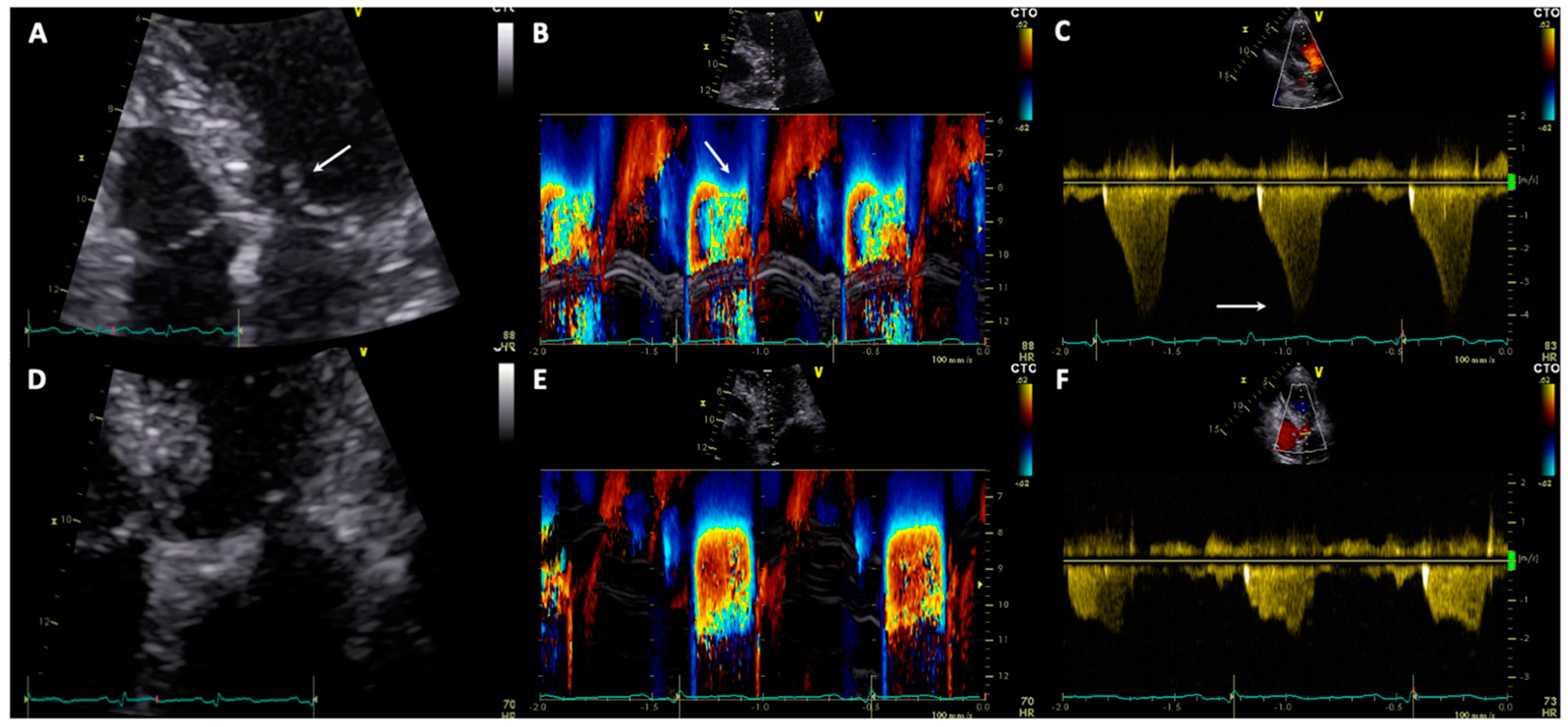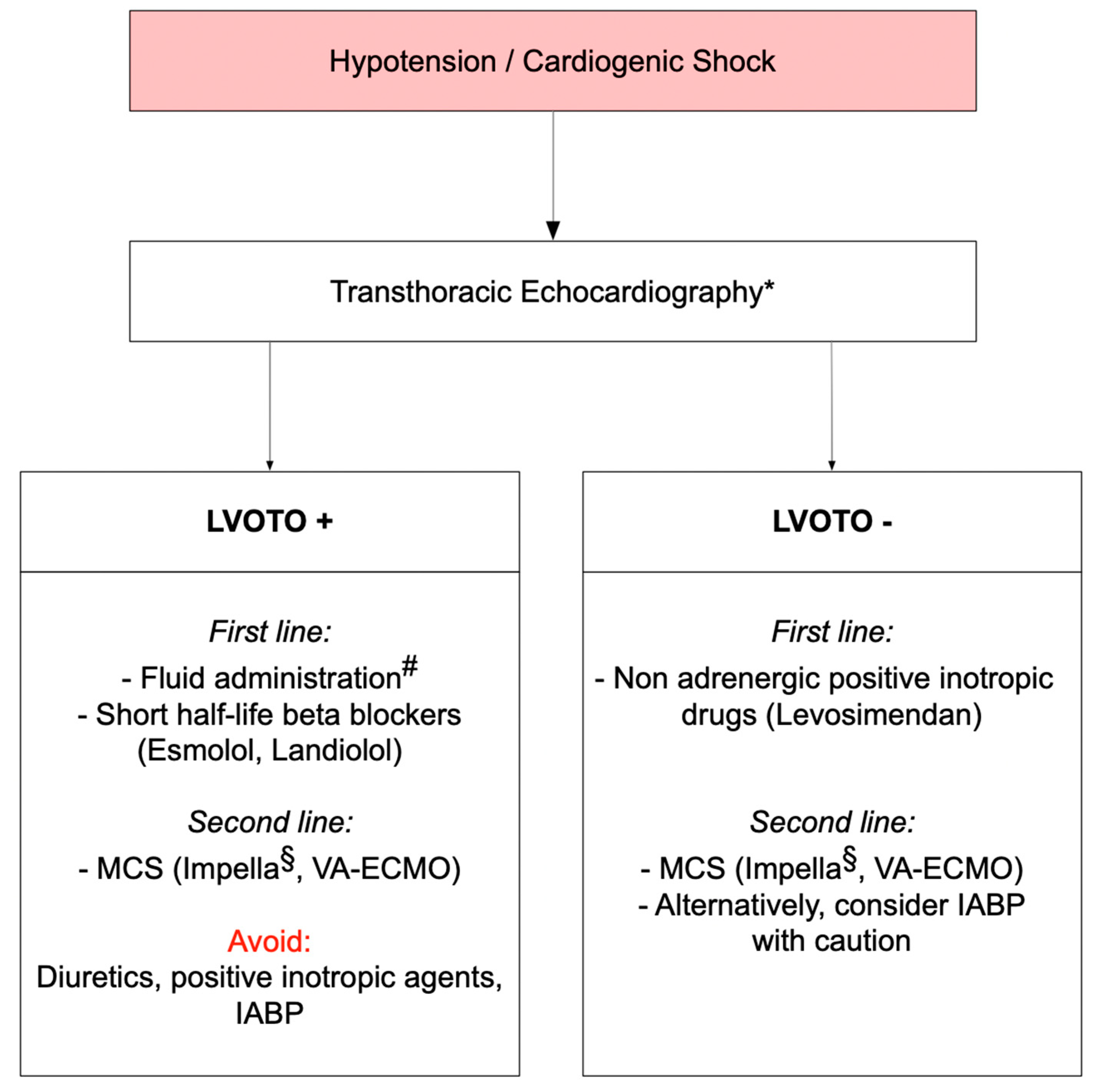Dynamic Left Intraventricular Obstruction Phenotype in Takotsubo Syndrome
Abstract
1. Takotsubo Syndrome: Clinical Characteristics and Outcomes
2. Dynamic Left Ventricular Outflow Tract Obstruction in Takotsubo Syndrome
2.1. Left Ventricular Outflow Tract Obstruction: Definition and Clinical Features
2.2. Pathophysiology and Prevalence of Left Ventricular Outflow Tract Obstruction in Takotsubo Syndrome
2.3. Acute Management of Patients with Takotsubo Syndrome Complicated by Left Ventricular Outflow Tract Obstruction
2.4. Late-Onset Left Ventricular Outflow Tract Obstruction in Takotsubo Syndrome: A Different Clinical Entity?
2.5. Follow-Up and Long-Term Management
3. Conclusions and Future Perspectives
Author Contributions
Funding
Institutional Review Board Statement
Informed Consent Statement
Conflicts of Interest
References
- Kurisu, S.; Sato, H.; Kawagoe, T.; Ishihara, M.; Shimatani, Y.; Nishioka, K.; Kono, Y.; Umemura, T.; Nakamura, S. Tako-tsubo-like left ventricular dysfunction due to multivessel coronary spasm. In Clinical Aspect of Myocardial Injury: From Ischemia to Heart Failure; Kodama, K., Haze, K., Hori, M., Eds.; Kagakuhyoronsha Publishing Co.: Tokyo, Japan, 1990; pp. 56–64. (In Japanese) [Google Scholar]
- Templin, C.; Ghadri, J.R.; Diekmann, J.; Napp, L.C.; Bataiosu, D.R.; Jaguszewski, M.; Cammann, V.L.; Sarcon, A.; Geyer, V.; Neumann, C.A.; et al. Clinical Features and Outcomes of Takotsubo (Stress) Cardiomyopathy. N. Engl. J. Med. 2015, 373, 929–938. [Google Scholar] [CrossRef]
- Sharkey, S.W.; Windenburg, D.C.; Lesser, J.R.; Maron, M.S.; Hauser, R.G.; Lesser, J.N.; Haas, T.S.; Hodges, J.S.; Maron, B.J. Natural history and expansive clinical profile of stress (tako-tsubo) cardiomyopathy. J. Am. Coll. Cardiol. 2010, 55, 333–341. [Google Scholar] [CrossRef] [PubMed]
- Kurisu, S.; Inoue, I.; Kawagoe, T.; Ishihara, M.; Shimatani, Y.; Nakamura, S.; Yoshida, M.; Mitsuba, N.; Hata, T.; Sato, H. Time course of electrocardiographic changes in patients with tako-tsubo syndrome: Comparison with acute myocardial infarction with minimal enzymatic release. Circ. J. 2004, 68, 77–81. [Google Scholar] [CrossRef] [PubMed]
- Prasad, A.; Lerman, A.; Rihal, C.S. Apical ballooning syndrome (Tako-Tsubo or stress cardiomyopathy): A mimic of acute myocardial infarction. Am. Heart J. 2008, 155, 408–417. [Google Scholar] [CrossRef]
- Napp, L.C.; Cammann, V.L.; Jaguszewski, M.; Szawan, K.A.; Wischnewsky, M.; Gili, S.; Knorr, M.; Heiner, S.; Citro, R.; Bossone, E.; et al. Coexistence and outcome of coronary artery disease in Takotsubo syndrome. Eur. Heart J. 2020, 41, 3255–3268. [Google Scholar] [CrossRef]
- Citro, R.; Okura, H.; Ghadri, J.R.; Izumi, C.; Meimoun, P.; Izumo, M.; Dawson, D.; Kaji, S.; Eitel, I.; Kagiyama, N.; et al. Multimodality imaging in takotsubo syndrome: A joint consensus document of the European Association of Cardiovascular Imaging (EACVI) and the Japanese Society of Echocardiography (JSE). J. Echocardiogr. 2020, 18, 199–224. [Google Scholar] [CrossRef]
- Eitel, I.; von Knobelsdorff-Brenkenhoff, F.; Bernhardt, P.; Carbone, I.; Muellerleile, K.; Aldrovandi, A.; Francone, M.; Desch, S.; Gutberlet, M.; Strohm, O.; et al. Clinical characteristics and cardiovascular magnetic resonance findings in stress (takotsubo) cardiomyopathy. JAMA 2011, 306, 277–286. [Google Scholar] [CrossRef]
- Citro, R.; Pontone, G.; Pace, L.; Zito, C.; Silverio, A.; Bossone, E.; Piscione, F. Contemporary Imaging in Takotsubo Syndrome. Heart Fail Clin. 2016, 12, 559–575. [Google Scholar] [CrossRef]
- Ghadri, J.R.; Wittstein, I.S.; Prasad, A.; Sharkey, S.; Dote, K.; Akashi, Y.J.; Cammann, V.L.; Crea, F.; Galiuto, L.; Desmet, W.; et al. International Expert Consensus Document on Takotsubo Syndrome (Part I): Clinical Characteristics, Diagnostic Criteria, and Pathophysiology. Eur. Heart J. 2018, 39, 2032–2046. [Google Scholar] [CrossRef]
- Lyon, A.R.; Bossone, E.; Schneider, B.; Sechtem, U.; Citro, R.; Underwood, S.R.; Sheppard, M.N.; Figtree, G.A.; Parodi, G.; Akashi, Y.J.; et al. Current state of knowledge on Takotsubo syndrome: A Position Statement from the Taskforce on Takotsubo Syndrome of the Heart Failure Association of the European Society of Cardiology. Eur. J. Heart Fail 2016, 18, 8–27. [Google Scholar] [CrossRef] [PubMed]
- Citro, R.; Bossone, E.; Parodi, G.; Carerj, S.; Ciampi, Q.; Provenza, G.; Zito, C.; Prota, C.; Silverio, A.; Vriz, O.; et al. Clinical profile and in-hospital outcome of Caucasian patients with takotsubo syndrome and right ventricular involvement. Int. J. Cardiol. 2016, 219, 455–461. [Google Scholar] [CrossRef] [PubMed]
- Prasad, A.; Dangas, G.; Srinivasan, M.; Yu, J.; Gersh, B.J.; Mehran, R.; Stone, G.W. Incidence and angiographic characteristics of patients with apical ballooning syndrome (takotsubo/stress cardiomyopathy) in the HORIZONS-AMI trial: An analysis from a multicenter, international study of ST-elevation myocardial infarction. Catheter Cardiovasc. Interv. 2014, 83, 343–348. [Google Scholar] [CrossRef] [PubMed]
- Bybee, K.A.; Prasad, A.; Barsness, G.W.; Lerman, A.; Jaffe, A.S.; Murphy, J.G.; Wright, R.S.; Rihal, C.S. Clinical characteristics and thrombolysis in myocardial infarction frame counts in women with transient left ventricular apical ballooning syndrome. Am. J. Cardiol. 2004, 94, 343–346. [Google Scholar] [CrossRef] [PubMed]
- Berton, E.; Vitali-Serdoz, L.; Vallon, P.; Maschio, M.; Gortani, G.; Benettoni, A. Young girl with apical ballooning heart syndrome. Int. J. Cardiol. 2012, 161, e4–e6. [Google Scholar] [CrossRef]
- Otillio, J.K.; Harris, J.K.; Tuuri, R. A 6-year-old girl with undiagnosed hemophagocytic lymphohistiocytosis and takotsubo cardiomyopathy: A case report and review of the literature. Pediatr. Emerg. Care 2014, 30, 561–565. [Google Scholar] [CrossRef] [PubMed]
- Wittstein, I.S.; Thiemann, D.R.; Lima, J.A.; Baughman, K.L.; Schulman, S.P.; Gerstenblith, G.; Wu, K.C.; Rade, J.J.; Bivalacqua, T.J.; Champion, H.C. Neurohumoral features of myocardial stunning due to sudden emotional stress. N. Engl. J. Med. 2005, 352, 539–548. [Google Scholar] [CrossRef] [PubMed]
- Luscher, T.F.; Templin, C. Is takotsubo syndrome a microvascular acute coronary syndrome? Towards of a new definition. Eur. Heart J. 2016, 37, 2816–2820. [Google Scholar] [CrossRef]
- Lyon, A.R.; Rees, P.S.; Prasad, S.; Poole-Wilson, P.A.; Harding, S.E. Stress (Takotsubo) cardiomyopathy—A novel pathophysiological hypothesis to explain catecholamine-induced acute myocardial stunning. Nat. Clin. Pract. Cardiovasc. Med. 2008, 5, 22–29. [Google Scholar] [CrossRef]
- Collet, J.P.; Thiele, H.; Barbato, E.; Barthelemy, O.; Bauersachs, J.; Bhatt, D.L.; Dendale, P.; Dorobantu, M.; Edvardsen, T.; Folliguet, T.; et al. 2020 ESC Guidelines for the management of acute coronary syndromes in patients presenting without persistent ST-segment elevation. Eur. Heart J. 2021, 42, 1289–1367. [Google Scholar] [CrossRef]
- Di Vece, D.; Citro, R.; Cammann, V.L.; Kato, K.; Gili, S.; Szawan, K.A.; Micek, J.; Jurisic, S.; Ding, K.J.; Bacchi, B.; et al. Outcomes Associated With Cardiogenic Shock in Takotsubo Syndrome. Circulation 2019, 139, 413–415. [Google Scholar] [CrossRef]
- Ghadri, J.R.; Wittstein, I.S.; Prasad, A.; Sharkey, S.; Dote, K.; Akashi, Y.J.; Cammann, V.L.; Crea, F.; Galiuto, L.; Desmet, W.; et al. International Expert Consensus Document on Takotsubo Syndrome (Part II): Diagnostic Workup, Outcome, and Management. Eur. Heart J. 2018, 39, 2047–2062. [Google Scholar] [CrossRef] [PubMed]
- Citro, R.; Rigo, F.; D’Andrea, A.; Ciampi, Q.; Parodi, G.; Provenza, G.; Piccolo, R.; Mirra, M.; Zito, C.; Giudice, R.; et al. Echocardiographic correlates of acute heart failure, cardiogenic shock, and in-hospital mortality in tako-tsubo cardiomyopathy. JACC Cardiovasc Imaging 2014, 7, 119–129. [Google Scholar] [CrossRef] [PubMed]
- Bonello, L.; Com, O.; Ait-Moktar, O.; Theron, A.; Moro, P.J.; Salem, A.; Sbragia, P.; Paganelli, F. Ventricular arrhythmias during Tako-tsubo syndrome. Int. J. Cardiol. 2008, 128, e50–e53. [Google Scholar] [CrossRef]
- Syed, F.F.; Asirvatham, S.J.; Francis, J. Arrhythmia occurrence with takotsubo cardiomyopathy: A literature review. Europace 2011, 13, 780–788. [Google Scholar] [CrossRef]
- Gili, S.; Cammann, V.L.; Schlossbauer, S.A.; Kato, K.; D’Ascenzo, F.; Di Vece, D.; Jurisic, S.; Micek, J.; Obeid, S.; Bacchi, B.; et al. Cardiac arrest in takotsubo syndrome: Results from the InterTAK Registry. Eur. Heart J. 2019, 40, 2142–2151. [Google Scholar] [CrossRef]
- Ding, K.J.; Cammann, V.L.; Szawan, K.A.; Stahli, B.E.; Wischnewsky, M.; Di Vece, D.; Citro, R.; Jaguszewski, M.; Seifert, B.; Sarcon, A.; et al. Intraventricular Thrombus Formation and Embolism in Takotsubo Syndrome: Insights From the International Takotsubo Registry. Arterioscler Thromb Vasc Biol. 2020, 40, 279–287. [Google Scholar] [CrossRef]
- Lu, D.Y.; Caplow, J.; Quatromoni, N.; Forde-McLean, R.; Owens, A.T. Ventricular Septal Defect from Takotsubo Syndrome. Case Rep. Cardiol. 2016, 2016, 2693062. [Google Scholar] [CrossRef] [PubMed]
- Jaguszewski, M.; Fijalkowski, M.; Nowak, R.; Czapiewski, P.; Ghadri, J.R.; Templin, C.; Rynkiewicz, A. Ventricular rupture in Takotsubo cardiomyopathy. Eur. Heart J. 2012, 33, 1027. [Google Scholar] [CrossRef] [PubMed][Green Version]
- Task Force, M.; Elliott, P.M.; Anastasakis, A.; Borger, M.A.; Borggrefe, M.; Cecchi, F.; Charron, P.; Hagege, A.A.; Lafont, A.; Limongelli, G.; et al. 2014 ESC Guidelines on diagnosis and management of hypertrophic cardiomyopathy: The Task Force for the Diagnosis and Management of Hypertrophic Cardiomyopathy of the European Society of Cardiology (ESC). Eur. Heart J. 2014, 35, 2733–2779. [Google Scholar] [CrossRef]
- Pelliccia, F.; Alfieri, O.; Calabro, P.; Cecchi, F.; Ferrazzi, P.; Gragnano, F.; Kaski, J.P.; Limongelli, G.; Maron, M.; Rapezzi, C.; et al. Multidisciplinary evaluation and management of obstructive hypertrophic cardiomyopathy in 2020: Towards the HCM Heart Team. Int. J. Cardiol. 2020, 304, 86–92. [Google Scholar] [CrossRef]
- Marian, A.J.; Braunwald, E. Hypertrophic Cardiomyopathy: Genetics, Pathogenesis, Clinical Manifestations, Diagnosis, and Therapy. Circ. Res. 2017, 121, 749–770. [Google Scholar] [CrossRef] [PubMed]
- La Canna, G.; Scarfo, I.; Arendar, I.; Alati, E.; Caso, I.; Alfieri, O. Phenotyping Left Ventricular Obstruction With Postprandial Re-Test Echocardiography in Hypertrophic Cardiomyopathy. Am. J. Cardiol. 2020, 125, 1688–1693. [Google Scholar] [CrossRef] [PubMed]
- Kobayashi, S.; Sakai, Y.; Taguchi, I.; Utsunomiya, H.; Shiota, T. Causes of an increased pressure gradient through the left ventricular outflow tract: A West Coast experience. J. Echocardiogr. 2018, 16, 34–41. [Google Scholar] [CrossRef] [PubMed]
- El Mahmoud, R.; Mansencal, N.; Pilliere, R.; Leyer, F.; Abbou, N.; Michaud, P.; Nallet, O.; Digne, F.; Lacombe, P.; Cattan, S.; et al. Prevalence and characteristics of left ventricular outflow tract obstruction in Tako-Tsubo syndrome. Am. Heart J. 2008, 156, 543–548. [Google Scholar] [CrossRef]
- De Backer, O.; Debonnaire, P.; Gevaert, S.; Missault, L.; Gheeraert, P.; Muyldermans, L. Prevalence, associated factors and management implications of left ventricular outflow tract obstruction in takotsubo cardiomyopathy: A two-year, two-center experience. BMC Cardiovasc Disord 2014, 14, 147. [Google Scholar] [CrossRef] [PubMed]
- Almendro-Delia, M.; Nunez-Gil, I.J.; Lobo, M.; Andres, M.; Vedia, O.; Sionis, A.; Martin-Garcia, A.; Cruz Aguilera, M.; Pereyra, E.; Martin de Miguel, I.; et al. Short- and Long-Term Prognostic Relevance of Cardiogenic Shock in Takotsubo Syndrome: Results From the RETAKO Registry. JACC Heart Fail 2018, 6, 928–936. [Google Scholar] [CrossRef]
- Parodi, G.; Del Pace, S.; Salvadori, C.; Carrabba, N.; Olivotto, I.; Gensini, G.F.; Tuscany Registry of Tako-Tsubo, C. Left ventricular apical ballooning syndrome as a novel cause of acute mitral regurgitation. J. Am. Coll. Cardiol. 2007, 50, 647–649. [Google Scholar] [CrossRef][Green Version]
- Sherrid, M.V.; Gunsburg, D.Z.; Moldenhauer, S.; Pearle, G. Systolic anterior motion begins at low left ventricular outflow tract velocity in obstructive hypertrophic cardiomyopathy. J. Am. Coll. Cardiol. 2000, 36, 1344–1354. [Google Scholar] [CrossRef]
- Sherrid, M.V.; Riedy, K.; Rosenzweig, B.; Massera, D.; Saric, M.; Swistel, D.G.; Ahluwalia, M.; Arabadjian, M.; DeFonte, M.; Stepanovic, A.; et al. Distinctive Hypertrophic Cardiomyopathy Anatomy and Obstructive Physiology in Patients Admitted With Takotsubo Syndrome. Am. J. Cardiol. 2020, 125, 1700–1709. [Google Scholar] [CrossRef] [PubMed]
- Dahhan, A.; Mohammad, A.; Kapoor, D.; Sharma, G.K. Hypotension due to dynamic left ventricular outflow tract obstruction after percutaneous coronary intervention. Tex. Heart Inst. J. 2011, 38, 723–726. [Google Scholar]
- Kato, K.; Di Vece, D.; Cammann, V.L.; Micek, J.; Szawan, K.A.; Bacchi, B.; Luscher, T.F.; Ruschitzka, F.; Ghadri, J.R.; Templin, C.; et al. Takotsubo Recurrence: Morphological Types and Triggers and Identification of Risk Factors. J. Am. Coll. Cardiol. 2019, 73, 982–984. [Google Scholar] [CrossRef]
- Santoro, F.; Ieva, R.; Ferraretti, A.; Fanelli, M.; Musaico, F.; Tarantino, N.; Martino, L.D.; Gennaro, L.D.; Caldarola, P.; Biase, M.D.; et al. Hemodynamic Effects, Safety, and Feasibility of Intravenous Esmolol Infusion During Takotsubo Cardiomyopathy With Left Ventricular Outflow Tract Obstruction: Results From A Multicenter Registry. Cardiovasc Ther. 2016, 34, 161–166. [Google Scholar] [CrossRef] [PubMed]
- Gassanov, N.; Er, F. The Role of Ultrarapid Acting Betablocker Esmolol and Landiolol in Critically Ill Patients. Dtsch Med. Wochenschr 2019, 144, 1280–1285. [Google Scholar] [CrossRef] [PubMed]
- Attisano, T.; Silverio, A.; Prota, C.; Briguori, C.; Galasso, G.; Citro, R. Impella in Takotsubo syndrome complicated by left ventricular outflow tract obstruction and severe mitral regurgitation. ESC Heart Fail 2020, 7, 306–310. [Google Scholar] [CrossRef] [PubMed]
- Yalta, K.; Yilmaztepe, M.; Ozkalayci, F.; Ucar, F. Tako-tsubo cardiomyopathy may lead to permanent changes in left ventricular geometry: Potential implications in the setting of pre-existing myocardial disease? Int. J. Cardiol. 2016, 202, 889–891. [Google Scholar] [CrossRef] [PubMed]
- Fu, H.; Jiao, Z.; Chen, K.; Liu, T.; Li, G. Dynamic left ventricular outflow tract obstruction in recovery process of stress cardiomyopathy. Int. J. Cardiol. 2016, 214, 202–203. [Google Scholar] [CrossRef]
- Yalta, K.; Yetkin, E. Late-onset dynamic outflow tract gradient in the setting of tako-tsubo cardiomyopathy: An interesting phenomenon with potential implications? Indian Heart J. 2017, 69, 328–330. [Google Scholar] [CrossRef]
- Schwarz, K.; Ahearn, T.; Srinivasan, J.; Neil, C.J.; Scally, C.; Rudd, A.; Jagpal, B.; Frenneaux, M.P.; Pislaru, C.; Horowitz, J.D.; et al. Alterations in Cardiac Deformation, Timing of Contraction and Relaxation, and Early Myocardial Fibrosis Accompany the Apparent Recovery of Acute Stress-Induced (Takotsubo) Cardiomyopathy: An End to the Concept of Transience. J. Am. Soc. Echocardiogr. 2017, 30, 745–755. [Google Scholar] [CrossRef]



Publisher’s Note: MDPI stays neutral with regard to jurisdictional claims in published maps and institutional affiliations. |
© 2021 by the authors. Licensee MDPI, Basel, Switzerland. This article is an open access article distributed under the terms and conditions of the Creative Commons Attribution (CC BY) license (https://creativecommons.org/licenses/by/4.0/).
Share and Cite
Di Vece, D.; Silverio, A.; Bellino, M.; Galasso, G.; Vecchione, C.; La Canna, G.; Citro, R. Dynamic Left Intraventricular Obstruction Phenotype in Takotsubo Syndrome. J. Clin. Med. 2021, 10, 3235. https://doi.org/10.3390/jcm10153235
Di Vece D, Silverio A, Bellino M, Galasso G, Vecchione C, La Canna G, Citro R. Dynamic Left Intraventricular Obstruction Phenotype in Takotsubo Syndrome. Journal of Clinical Medicine. 2021; 10(15):3235. https://doi.org/10.3390/jcm10153235
Chicago/Turabian StyleDi Vece, Davide, Angelo Silverio, Michele Bellino, Gennaro Galasso, Carmine Vecchione, Giovanni La Canna, and Rodolfo Citro. 2021. "Dynamic Left Intraventricular Obstruction Phenotype in Takotsubo Syndrome" Journal of Clinical Medicine 10, no. 15: 3235. https://doi.org/10.3390/jcm10153235
APA StyleDi Vece, D., Silverio, A., Bellino, M., Galasso, G., Vecchione, C., La Canna, G., & Citro, R. (2021). Dynamic Left Intraventricular Obstruction Phenotype in Takotsubo Syndrome. Journal of Clinical Medicine, 10(15), 3235. https://doi.org/10.3390/jcm10153235







